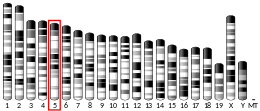MEPE
Matrix extracellular phosphoglycoprotein (Osteoblast/osteocyte factor 45) is a protein that in humans is encoded by the MEPE gene.[5][6] A conserved RGD motif is found in this protein, and this is potentially involved in integrin recognition.[7]
| Osteoregulin | |||||||||
|---|---|---|---|---|---|---|---|---|---|
| Identifiers | |||||||||
| Symbol | Osteoregulin | ||||||||
| Pfam | PF07175 | ||||||||
| InterPro | IPR009837 | ||||||||
| |||||||||
References
- GRCh38: Ensembl release 89: ENSG00000152595 - Ensembl, May 2017
- GRCm38: Ensembl release 89: ENSMUSG00000053863 - Ensembl, May 2017
- "Human PubMed Reference:". National Center for Biotechnology Information, U.S. National Library of Medicine.
- "Mouse PubMed Reference:". National Center for Biotechnology Information, U.S. National Library of Medicine.
- Rowe PS, de Zoysa PA, Dong R, Wang HR, White KE, Econs MJ, Oudet CL (1 July 2000). "MEPE, a new gene expressed in bone marrow and tumors causing osteomalacia". Genomics. 67 (1): 54–68. doi:10.1006/geno.2000.6235. PMID 10945470.
- "Entrez Gene: MEPE matrix, extracellular phosphoglycoprotein with ASARM motif (bone)".
- Petersen DN, Tkalcevic GT, Mansolf AL, Rivera-Gonzalez R, Brown TA (November 2000). "Identification of osteoblast/osteocyte factor 45 (OF45), a bone-specific cDNA encoding an RGD-containing protein that is highly expressed in osteoblasts and osteocytes". J. Biol. Chem. 275 (46): 36172–80. doi:10.1074/jbc.M003622200. PMID 10967096.
Further reading
- Quarles LD (2003). "FGF23, PHEX, and MEPE regulation of phosphate homeostasis and skeletal mineralization". Am. J. Physiol. Endocrinol. Metab. 285 (1): E1–9. doi:10.1152/ajpendo.00016.2003. PMID 12791601.
- Ogbureke KU, Fisher LW (2005). "Renal expression of SIBLING proteins and their partner matrix metalloproteinases (MMPs)". Kidney Int. 68 (1): 155–66. doi:10.1111/j.1523-1755.2005.00389.x. PMID 15954904.
- Ogbureke KU, Fisher LW (2004). "Expression of SIBLINGs and their partner MMPs in salivary glands". J. Dent. Res. 83 (9): 664–70. doi:10.1177/154405910408300902. PMID 15329369.
- Jain A, Fedarko NS, Collins MT, et al. (2004). "Serum levels of matrix extracellular phosphoglycoprotein (MEPE) in normal humans correlate with serum phosphorus, parathyroid hormone and bone mineral density". J. Clin. Endocrinol. Metab. 89 (8): 4158–61. doi:10.1210/jc.2003-032031. PMID 15292364.
- Nampei A, Hashimoto J, Hayashida K, et al. (2005). "Matrix extracellular phosphoglycoprotein (MEPE) is highly expressed in osteocytes in human bone". J. Bone Miner. Metab. 22 (3): 176–84. doi:10.1007/s00774-003-0468-9. PMID 15108058.
- MacDougall M, Simmons D, Gu TT, Dong J (2003). "MEPE/OF45, a new dentin/bone matrix protein and candidate gene for dentin diseases mapping to chromosome 4q21". Connect. Tissue Res. 43 (2–3): 320–30. doi:10.1080/713713461. PMID 12489176.
- Argiro L, Desbarats M, Glorieux FH, Ecarot B (2001). "Mepe, the gene encoding a tumor-secreted protein in oncogenic hypophosphatemic osteomalacia, is expressed in bone". Genomics. 74 (3): 342–51. doi:10.1006/geno.2001.6553. PMID 11414762.
This article is issued from Wikipedia. The text is licensed under Creative Commons - Attribution - Sharealike. Additional terms may apply for the media files.




